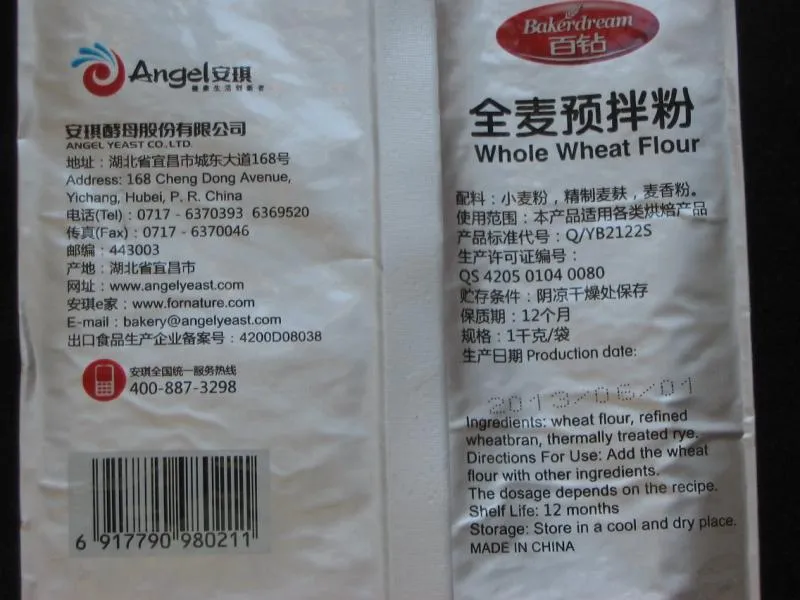
I just bought this "Whole Wheat Flour" from a bakery supply store near my home in NW China. Can anyone tell me how to put it to the best use?
Here's a picture of the back of the package:
Image

Here's a close-up of the flour:
Image

When I mix it with water it becomes very dark brown and extremely sticky. If I don't add AP flour it is quite unmanageable!
Can anyone give me a suggestion of the easiest ways to use this flour? Thanks!
Keriann
只能说……加油!哈哈
What happens if you add more? Still sticky? Also, sometimes when I'm mixing up a 100% whole wheat dough it feels really sticky, but if you wet your hands and fold it a few times, it will start to become more doughlike. I mean like press down, fold, press down, fold... You can also try letting it set for 30-60 minutes to soak up the water better.
Also in the off chance you take my comment above literally, adding oil would probably not help too much ;-) Although a little does help the dough become more supple.
I also notice it says 麦香粉 on the ingredients, so ... there's some chance whatever that is (thermally treated rye o_O) is making it sticky. You might be out of luck.
http://en.angelyeast.com/product/19842.html
The directions on this page look like it is meant to be an additive:
I cannot find too much info on heat treated flours but what I do find is that it is used in food production to increase and stabilize the viscosity of the final food product. The grain involved may stay viscous without the sauce separating.
Actually, now that I talk, it may make sense that this is an additive to other flours in a bread recipe. It may act as a tangzhong and provide a starchy gel for the dough to increase the softness of the crumb. The recipe will probably need more liquid than originally called for in order to work as the additive requires a lot of liquid, usually.Here is a great reference for tangzhong :
http://www.thefreshloaf.com/node/32997/hokkaido-milk-bread-tangzhong
Good luck and let us know what happens.
The 10%-20% means that if you have a recipe with 1000g total flour, 100-200g of the additive is used. As for liquid, I would think that using 80%-100% hydration of the additive would be reasonable. 100g additive mixed with 80g-100g water. Allow to sit for 30 minutes to fully absorb then mix with dough.
OR
On the first attempt, I would try and match the dough consistency of the additive with that of the original recipe and then mix them together well.
Thanks for your comments/suggestions! I found a recipe for a pumpernickel bread that worked quite nicely. I just used this flour in place of the rye flour. It turned out just right!
I'm still wondering what exactly "thermally treated rye" is, but it makes a nice, brown bread!
Keriann
I am NOT an expert but I believe that "thermally treated" rye is rye flour heated under certain conditions and they do that to "set" its characteristic. It most likely stabilizes how it will react in a dough as an additive.
Sounds like it was perfect for your pumpernickel. Any idea what percentage it was in your dough?
Rye usually contains a lot of starch and protein digesting enzymes. My guess is that thermal treating either speeds these up -- think malting -- or completely inactivates them. It's more likely inactivating them, with a bit of enzyme activity as a by-product. Lots of people use rye flour as a sourdough because the acids inactivate the undesired enzymes.
I think the biggest reason the rye is there is like others said, make the dough more viscous.
Also I don't think the dosage is really relevant, it's probably a thing where they're suggesting that you use 10-20% if you want to make breads like normal.
If you want the dough to not be so sticky, let it autolyze and maybe do a sourdough treatment.